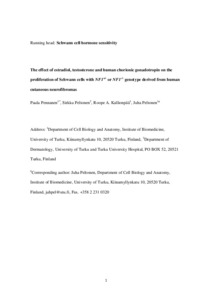The effect of estradiol, testosterone, and human chorionic gonadotropin on the proliferation of Schwann cells with NF1 +/− or NF1 −/− genotype derived from human cutaneous neurofibromas
Sirkku Peltonen; Paula Pennanen; Juha Peltonen; Roope A. Kallionpää
https://urn.fi/URN:NBN:fi-fe2021042718152
Tiivistelmä
Dermal neurofibromas are the hallmarks of neurofibromatosis type 1 (NF1). Neurofibromas harbor Schwann cells with two different genotypes: Schwann cells which carry the germline mutation and a healthy NF1 allele (NF1 +/−), and a subpopulation of Schwann cells which harbor the so-called second hit leading to inactivation of both NF1 alleles (NF1 −/−). The second hit in the NF1 gene of Schwann cells is considered to be the initial step in the development of neurofibromas. Dermal neurofibromas typically start to grow in puberty, and their number and size increase during pregnancy, indicating hormone responsiveness. This is the first study to address the effect of human chorionic gonadotropin (hCG) on the proliferation of human NF1 +/− and NF1 −/− Schwann cells in vitro. In addition, the effects of estradiol and testosterone were also investigated. The results showed that NF1 −/− Schwann cells were more sensitive to estradiol, testosterone, and human chorionic gonadotropin than NF1 +/− cells. Specifically, the proliferation of NF1 −/− Schwann cells was increased by up to 99, 110, and 170% compared to vehicle control when treated with estradiol, testosterone, and hCG, respectively. Interestingly, no effect of estradiol, testosterone, or hCG on the proliferation of the cells with NF1 +/− genotype was observed. To conclude, the somatic second hit in the NF1 gene sensitizes Schwann cells to sex hormones resulting in a highly increased proliferation. Our results highlight the significance of sex hormones in the regulation of neurofibroma growth.
Kokoelmat
- Rinnakkaistallenteet [19207]
